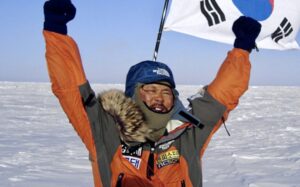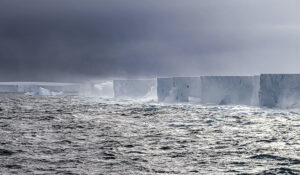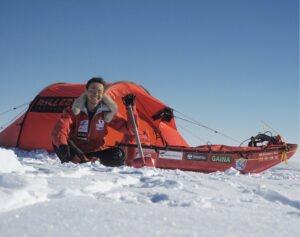An all-female team of Soviet women in fur hats and ski boots carved their path across the Arctic and Antarctic in a quiet rebellion against male dominance in the polar regions. They called themselves Metelitsa, a Russian word for “blizzard.”
As the story goes, on June 5, 1976, these women of Metelitsa sprayed Sredny Island’s polar station — completely dominated by men — with perfume. At the time, perfume was a scarce luxury in the USSR.
On arctic island after island, this spraying became a signature quirk in their routine. Metelitsa conquered the harshest terrain equipped with bikinis, makeup mirrors, mascara, lipstick, and hand-embroidered handkerchiefs.
This was an unusual approach in the country still busy building Communism, diverting Siberian rivers to irrigate the deserts of Central Asia, and conquering the cosmos. At that time, in the late 1960s and early 1970s, the Soviet Union wanted to dominate nature to showcase its culture’s supremacy.
Metelitsa symbolized a struggle of a different kind — proving that women belonged in the polar regions.

Long before Instagram, a member of Metelitsa vamps it up on the sea ice. Photo: Metelitsa
They glided over the ice on rickety wooden skis, equipped not just with sleeping bags and parkas but also AKMs and IZH-56s, to protect themselves from polar bears.

Valentina Kuznetsova, the founder of Metelitsa. Photo: Metelitsa
Metelitsa begins
In 1966, Valentina Kuznetsova, a radio engineer and skier, forged the team from former competitive skiers. By their early 30s, they were already part of an older generation of athletes.
As retirement beckoned, Kuznetsova’s friends found a new dream to pursue: skiing across the Antarctic. Their group boasted PhDs, doctors, meteorologists, ex-astronauts, and Olympians.
But men were doubtful. Even Dmitri Shparo, the famous Soviet polar explorer who lived in the same high-rise neighborhood as Kuznetsova and spoke with her often, told me recently, “I could easily imagine a girl skiing to the Pole solo and even unsupported, but a girls’ team? With egos crashing and temperaments colliding? This would be a catfight 24/7. For me, this was just inconceivable.”
By that time Shparo had already successfully skied to the North Pole — the first group of skiers to get there. To do so, they brazenly defied the Politburo, which had initially denied them permission.

Dmitri Shparo, a few years after skiing to the North Pole. Photo: Jerry Kobalenko
Diplomatic defiance
Kuznetsova and her colleagues sought to defy these preconceptions. They had the skills and training, but they too needed to overcome the resistance of an aging, male-dominated Soviet Politburo.
In the forbidden Soviet Arctic, you needed a special permit to travel. Only the KGB and Communist politicians could dispense this. Thus Metelitsa’s quest was twofold: navigating the icy expanses and persuading these unyielding patriarchs to approve their project.
They decided to approach this untraditional idea traditionally — by playing on both their femininity and their athletic competence.
So, they took selfies to convey their story in images that no male in the Soviet Politburo would ever ignore.

Hamming it up. Photo: Metelitsa
I should perhaps explain: We young Soviet girls were expected to emulate classic femininity out of 1950s Western male dreams, all the while driving tractors and working in space engineering. To revolt against society’s norms, we had to use some of these old tools to push forward on our mission. Imagine my grandmother, a field surgeon fresh from the front lines, wearing stilettos while crammed into an overcrowded bus on her way to work. This was perfectly normal in the USSR.

As part of their strategy, a member of Metelitsa flaunts both toughness and beauty.
Building up credibility
In 1966, Metelitsa embarked on an ultramarathon, skiing from Moscow to Leningrad, now St. Petersburg — a staggering 766km. Their official aim? Outpace a male nuclear physicists’ team, which had covered the same route in 6.5 days.
The women didn’t quite succeed — they finished in 7.5 days — but this was enough to earn press attention and mild acclaim among the leadership of Komsomol, the youth wing of the Communist Party.

Skiing to St. Petersburg. Photo: Metelitsa
Soon after that, they tried to organize a ski ultramarathon to Norway, famous for its love of skiing. However, the Soviet Union’s invasion of Czechoslovakia in 1968 brought that project to a halt.
Navigating unfamiliar corridors of power and diplomacy, the women received permission in 1969 to enter Finland, which had stayed neutral throughout the Cold War. They then skied a formidable 2,600km from Moscow to Tornio, Finland. This became Metelitsa’s longest expedition.
My father, Boris Batsanov, who later became chief of staff for the Soviet Prime Minister, was also a native Finnish speaker and a close friend of Finnish President Urho Kekkonen. He convinced Kekkonen, an ardent skier himself, that these women were an asset for détente. So in Helsinki, Kekkonen greeted them.

Urho Kekkonen, the President of Finland, greets the Metelitsa skiers. Photo: Metelitsa
Gaining recognition
Now Metelitsa, like their male predecessor Shparo, were sometimes recognized in the streets of Soviet towns and earned a welcome in Communist male rulers’ offices.
But skiing to the South Pole was still a distant dream. Back then, in the late 1960s and early 1970s, no woman could even work in Antarctica.
So the women of Metelitsa had, once again, to prove their worthiness.
Skiing across Severnaya Zemlya and Franz Joseph Land, they crossed the treacherous Vilkitsky Strait. To please the Communist politicians, they carried Lenin’s bust with them across the drifting ice. At the same time, they posed near open water like seals, reciting poetry and taking pictures.
They had an idea. Beyond cheesecake photos in bikinis, they concocted a shrewder way to use their bodies — by serving Soviet science.
They made the acquaintance of Lieutenant General Oleg Gazenko. He was the maestro of the Institute for Biomedical Problems, which dealt with air and space physiology.
Gazenko was behind the two dogs, Belka and Strelka, sent into orbit as a kind of scientific theater.
I interviewed Gazenko in 1983, five years before Metelitsa’s expedition to the Antarctic. He claimed that stray dogs were prime candidates for his research. Like victims of Nazi occupation, hunger, and war, these resilient canines were paragons of survival.
Working for the space program
The Metelitsa women convinced him that their indomitable spirit made them even better candidates for study. So from then on, their secondary job on these grueling expeditions was to collect blood, urine, and other telltale biomarkers vital for the Soviet odyssey into space.
With this backing, Metelitsa finally won permission to go to the Antarctic.
By now, however, they were no longer girls, but seasoned mothers and grandmothers. Valentina Kuznetsova was 51, and her compatriots were likewise older and weathered by time and experience.
Their moment to set foot in Antarctica had come a little late, but it had come and they were ready.

The skiers take a break. Photo: Metelitsa
A forbidden world for women
I had a long talk with Valentina Kuznetsova in the fall of 1988, just a few weeks before she left for the Antarctic. We shared our experiences about life on the ice. As a journalist, I specialized in covering the polar regions. Our encounters with polar men were similar. We saw them as heroes, but the men did not reciprocate our admiration.
Before my first season on a drifting Soviet station on the Arctic Ocean, I was asked to “publicly and in writing deny my womanhood.” It meant that I would never be allowed female privacy out there. No separate bathrooms or showers or quarters, nothing. Telegrams went back and forth before I had permission to land, and I agreed to all the conditions.
“We will see you as a man, and if you complain, you will pay the price,” they warned.
I realize it’s hard for younger generations reading this to understand. But for us, born soon after WWII, it was just a part of the deal if we wanted a certain freedom. We took it with as much good humor as we could.
So Valentina Kuznetsova and I laughed about these small, shared inconveniences. For her, dealing with the structures of power was more difficult than dealing with a culture of misogyny. But she needed an alliance with that power to realize her dream of skiing in the Antarctic.
Antarctica at last
In December of 1988, nine members of Metelitsa landed at the first Soviet Antarctic science station, Mirny. They intended to ski to Vostok, another station further inland, 1,420km away. Because the South Pole was a U.S. base, they would not pass that way.

Metelitsa skiers. Photo: Metelitsa
Kuznetsova updated us at the news desk at Pravda via radio, as we covered their progress. They started in very mild weather, 0˚C during the daytime. They skied in long-sleeved wool shirts and did 10-hour shifts with a one-hour lunch stop and short breaks.
After the first 100km, they had climbed to 1,500m. Wind and storms intensified and the nights got much colder: -25˚C. Two “security” vehicles accompanied the team, so admittedly the women were hardly unsupported.

Setting up camp. Photo: Metelitsa
The entire December, they busily planned the New Year’s celebration. After 70 years of government-mandated atheism, Christmas was not a big deal, but New Year’s was. They had costumes, staged a theater production, and took photo sessions in the tent, which increased the expedition’s celebrity.
In mid-January, they reached Komsomolskaya, another Soviet polar station. Here, they learned that the old gents in the Kremlin had been watching them “with precision.”
At the beginning of February, they arrived at Vostok, their final destination. They had skied for 57 days, and survived -52˚C nights and -48°C days. They had succeeded.
On this journey, Valentina’s 27-year-old daughter Irina accompanied her as a photographer. Later, Irina wrote a book about this journey and everything that preceded it, called Metelitsa. Almost impossible to find now except maybe in Russia, it was put out by publisher Frederik Paulsen in Moscow.
Finally, the South Pole
Seven years later, in 1996, five years after the collapse of the Soviet Union, six members of the Metelitsa team reached the South Pole. Ironically, Valentina Kuznetsova herself, the founder of Metelitsa, could not join the expedition.
This time, her lack of participation was not because of suspicious males or prickly bureaucracy, but because of a new reality many Russians had not yet learned to deal with: the market economy.
In Soviet times, you didn’t have to raise funds, you just needed official permission. With that, all doors opened for you. Now, the women had to pay themselves for air tickets, hotels, everything. This transition from socialism to a market economy was difficult for many.
So four women, including Kuznetsova, reluctantly stayed behind in Chile, and six skied the last two degrees, from 88˚S to the Amundsen-Scott South Pole Station. It took them 13 days.
Now, in late 2023, pretty much no one in modern Russia remembers Metelitsa. Valentina Kuznetsova died in 2010. Her daughter Irina moved to Paris and then to the U.S. I live in the U.S. too, and because of certain opinions of mine, I am no longer welcome in the country where I grew up. Metelitsa still exists as a humanitarian NGO, helping people with disabilities.
Only a few of us old-timers remember those days and look back fondly at those forgotten photos of these pioneering polar women.

A who’s who of Russian explorers in 1995. Left to right, Mikhail Malakhov, Yuri Senkevich, Vladimir Chukov, Artur Chilingarov, Valentina Kuznetsova, Fedor Konyukhov, Viktor Boyarsky. Photo: Metelitsa






